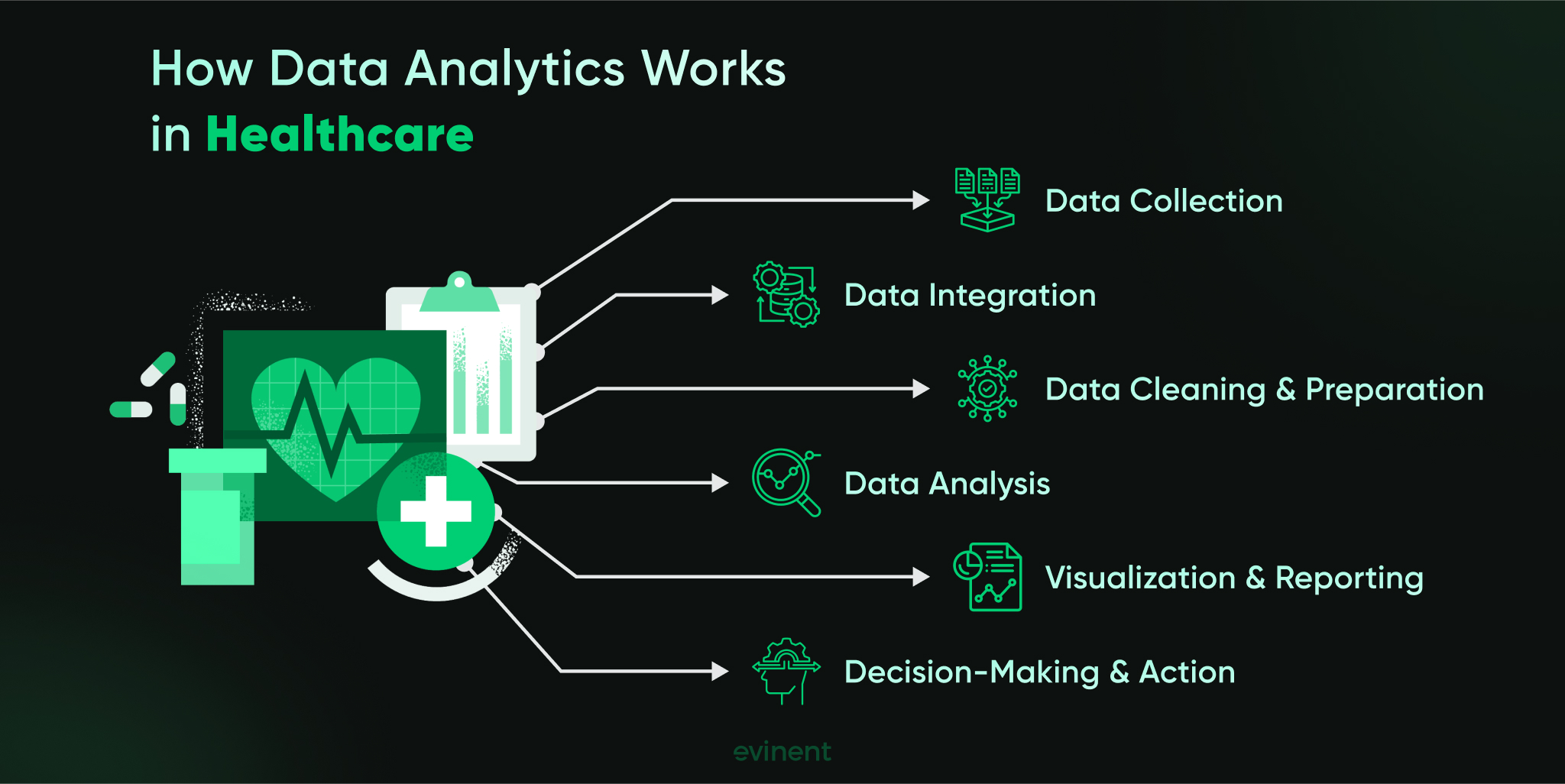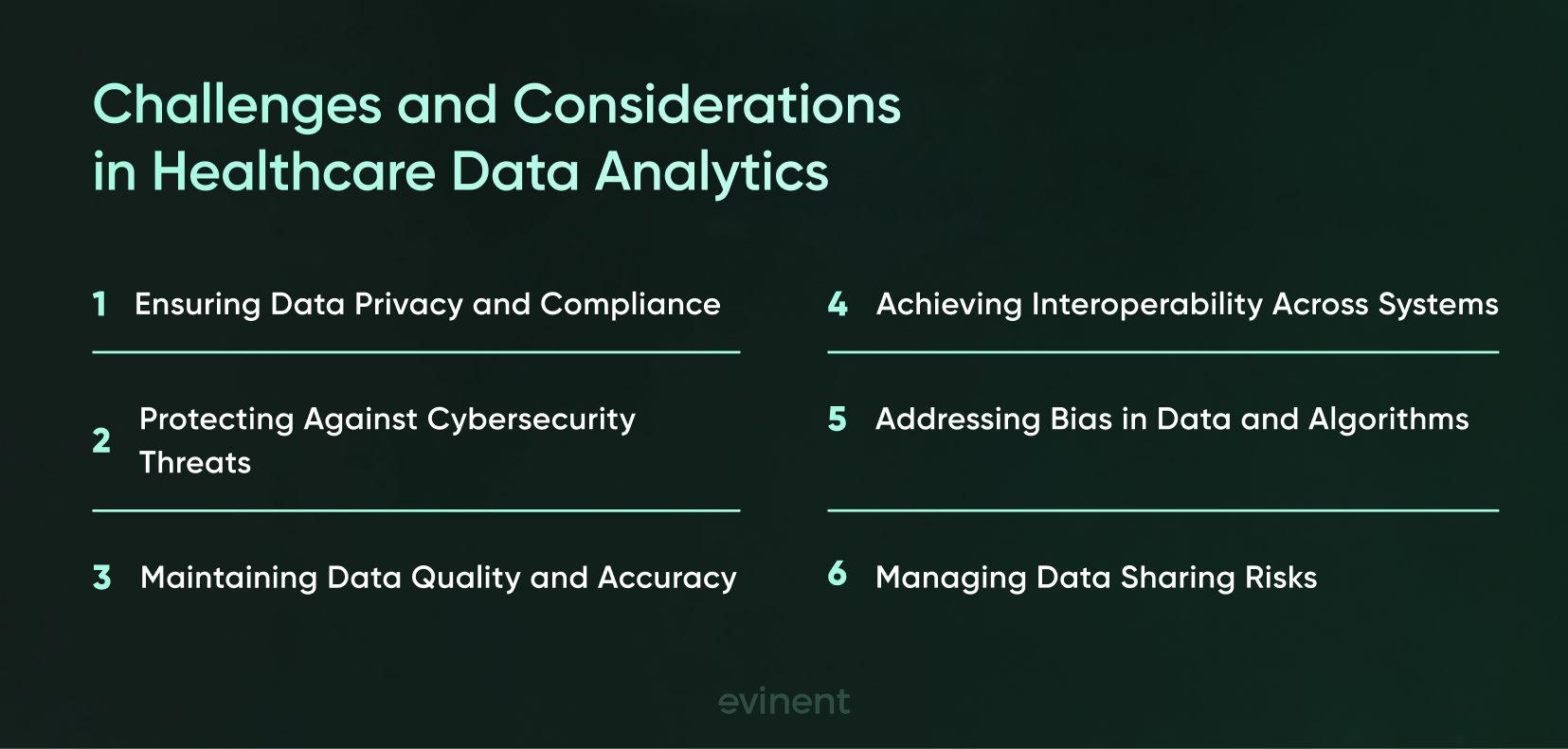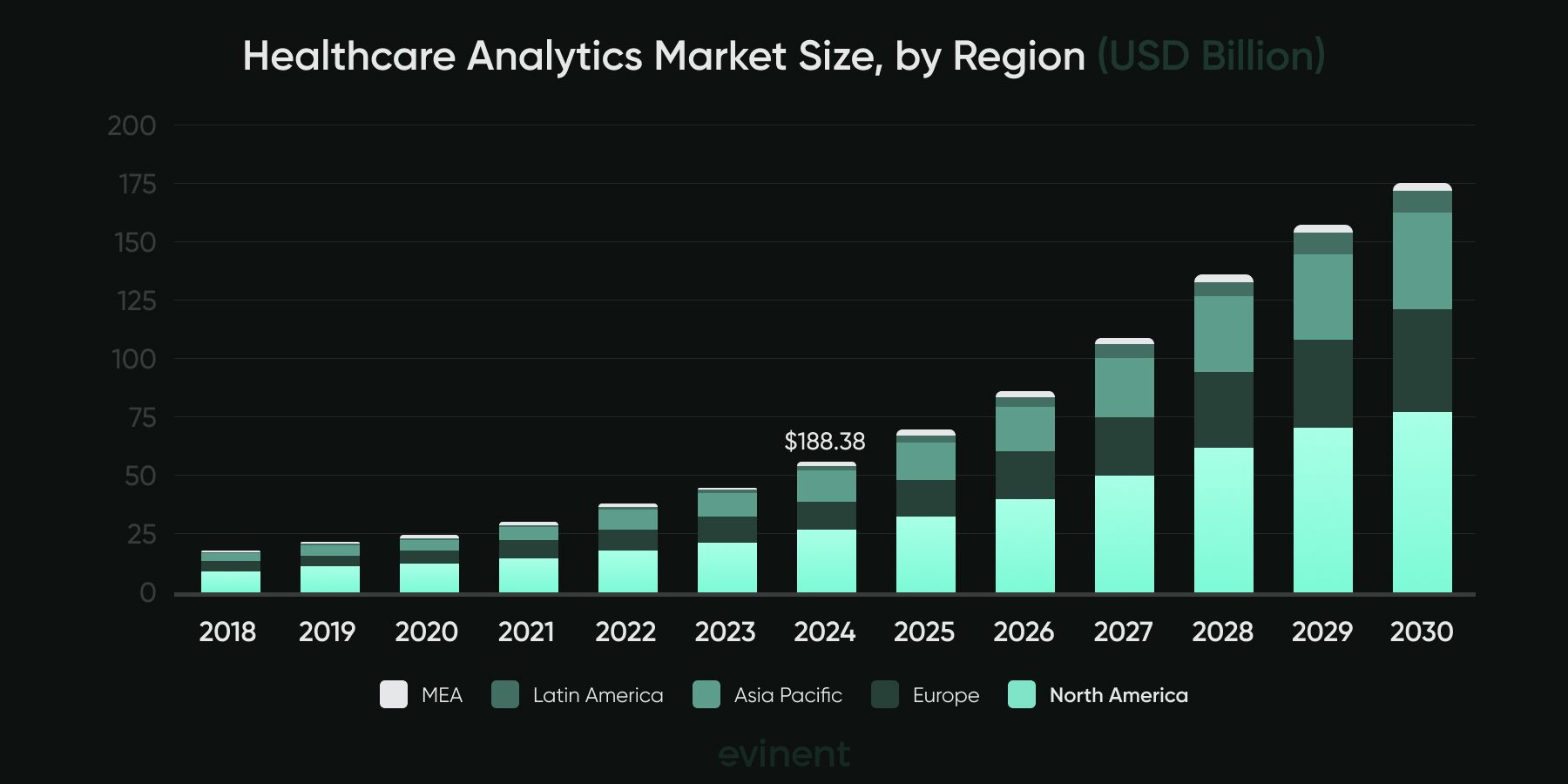What is Data Analytics in Healthcare?
Data analytics in healthcare means the methodical gathering, managing, and understanding of medical and operational data for the purpose of making improved clinical decisions, maximizing healthcare services, and enhancing patient outcomes. It integrates different data sources, including electronic health records, medical imaging, public health statistics, and clinical trial results, and it utilizes innovative methods such as predictive modeling, machine learning, and population health analysis.
This article is about how healthcare organizations leverage data analytics in many fields, including telemedicine, advanced imaging analysis, early disease detection, personalized medicine, fraud prevention, and efficient workforce management. We will identify the advantages for patient care and business operations, the part played by big data and new technologies, methods for effective implementation, issues such as data privacy and interoperability, and the future trends that are changing the industry. Ultimately, we will also highlight the key types of healthcare analytics and what is the role of data analytics in healthcare.
Real-World Applications of Healthcare Data Analytics
Healthcare data analytics is the influence leading changes to the whole healthcare system, to the methods of diagnosis, treatment, and to the healthcare organizations themselves. Managing and analyzing vast volumes of data derived from medical and operational activities, healthcare analytics is the enabler of early detection of diseases, the improvement of people's health, and the even use of healthcare resources. The following are some of the areas where the most significant changes have been made in healthcare lately.
Telemedicine and Remote Patient Monitoring
Telemedicine is one of the main tools that have made it possible for healthcare to reach rural areas, patients who are confined to home, and those suffering from chronic diseases. By means of analytics, the medical practitioners are capable of managing the real-time data coming from the wearables, health applications for mobile devices, and monitoring equipment at home to identify the early warning symptoms, follow the recovery of the patient, and customize the treatment plan without having to physically visit the doctor. In this way, the access becomes preventive, and the rate of hospital readmissions is lowered.
Electronic Health Records (EHR) Optimization
While electronic health records are packed with patient medical histories, it is the organized analysis that really brings out their value. To understand performance, consumer data, as well as diagnostic results, providers can locate areas where the quality of attending improves the accuracy of the documentation and, in turn, use clinical evidence-based decisions. This, furthermore, facilitates the prevention of medical errors, and the synergies between the different fields of medicine are enhanced.
Advanced Medical Imaging Analysis
Advanced medical imaging analysis uses AI-driven algorithms to interpret CT scans, MRIs, and X-rays more accurately and quickly. This technology assists radiologists in identifying subtle tissue changes, detecting tumors in early stages, and monitoring disease progression over time. It improves diagnostic precision and speeds up treatment planning, especially for complex conditions such as cancer or cardiovascular diseases
Early Disease Detection and Predictive Analytics
By combining demographic information, genetic data, and lifestyle factors, predictive analytics can identify patients at risk of developing specific diseases years before symptoms occur. This makes it possible to recommend preventive treatments, regular screenings, and lifestyle changes early, lowering the likelihood of complications and reducing long-term healthcare costs.
“Predictive analytics in health care has generated increasing enthusiasm recently, as reflected in a rapidly growing body of predictive models reported in literature and in real-time embedded models using electronic health record data.” (Liu, V. X. et al., Applied Clinical Informatics).
Fraud Detection in Healthcare Claims
Fraud detection systems examine numerous transactions related to billing and claims to discover the outlying patterns that could be fraudulent activities - for instance, the same claim submitted several times, the use of unneeded medical procedures, or the issuance of false prescriptions. Such systems act as a security measure for the economic welfare of healthcare institutions and also make sure that money is allocated to real patient care.
Resource Allocation and Workforce Management
Through data analytics, medical facilities are able to make the best use of their resources through the process of forecasting patient admission rates, recognizing the periods of maximum demand, and adjusting the staff that is available. Thereby, it becomes possible to avoid the situations of both insufficiency of staff, which can endanger the quality of care, and the surplus of staff, which leads to an increase in costs. In addition, it also facilitates the availability of vital instruments and materials in locations where
From telemedicine and electronic health records to advanced medical imaging analysis and predictive analytics, the applications of medical data analytics are extensive and transformative. They improve the speed and accuracy of diagnoses, reduce costs, and enhance patient satisfaction. As the healthcare industry continues to evolve, organizations that embrace these technologies will be better positioned to provide high-quality, efficient, and patient-centered care.
How Healthcare Data Analytics Works
Healthcare data analytics involves a sequential procedure that changes unprocessed healthcare data into knowledge that can be used for clinical and administrative decision-making. Every phase is of the same importance and lays the groundwork for the next one.

Step 1 – Data Collection
Healthcare entities collect data from electronic health records, medical imaging, wearable devices, lab results, and clinical trials. The goal of this step is to build a data foundation that is complete in both the health of the patients and the operations of the system. The whole analytics flow becomes worthless if there are not enough diverse and accurate data inputs.
Step 2 – Data Integration
As medical records are in different formats and systems, integration is compulsory to merge them into a single repository, like data warehouses or data lakes. This process eradicates silos and s that data in different formats can be processed together. Consequently, clinicians and administrators have a holistic overview of patient care.
Step 3 – Data Cleaning & Preparation
Raw medical data is pretty much always not in a form that can be directly used for analysis. Data cleaning encompasses a multitude of smaller tasks, including error correction, standardizing data formats, removing duplicates, and so on. The step of data cleaning ensures that the whole analytics process relies on quality and consistent records rather than on errors and anomalies.
Step 4 – Data Analysis
At this stage, statistical techniques, machine learning models, and predictive analytics are applied to uncover trends and risk factors. For example, algorithms may identify early signs of chronic disease or forecast patient readmissions. The purpose is to transform validated data into insights that can improve medical outcomes.
Step 5 – Visualization & Reporting
So these insights are really changed to the visualizations such as dashboards, reports, and clinical decision support tools. Such forms enable doctors, administrators, and making authorities to grasp the trend quickly and take suitable actions. Unambiguous presentation is important as it is the link between complicated analytics and the practical healthcare field.
Step 6 – Decision-Making & Action
Finally, insights are applied in practice: physicians design personalized treatments, hospitals optimize resource allocation, and insurers detect fraudulent claims. This step closes the loop by ensuring that analytics directly contributes to better patient outcomes, cost savings, and higher operational efficiency.
Healthcare data analytics is a dynamic and continuous process that transforms raw medical data into actionable insights. By following a structured workflow—from data collection to decision-making—healthcare providers can improve patient care, streamline operations, and reduce costs. As technology and analytics methods advance, the ability to extract meaningful insights will continue to evolve, making data-driven healthcare an indispensable part of modern medicine.
7 Key Benefits and Impact of Data Analytics in Healthcare
Data analysis in healthcare is transforming this industry by delivering measurable benefits in patient outcomes, operational performance, and cost management. By analyzing vast amounts of medical and operational data, healthcare providers can make smarter decisions, improve care delivery, and plan more effectively for the future. For instance, the WHO highlights that early intervention and personalized treatment significantly reduce the burden of chronic diseases, which makes predictive analytics especially valuable. This section previews the most important areas where analytics makes a tangible difference.

Chronic Disease Management and Personalized Treatment Plans
Through analytics, healthcare providers can monitor chronic illnesses in a more accurate way and create custom treatment plans that match the patient's specific requirements. This not only results in better control of the diseases, reduced visits to the hospital, and enhanced quality of life, but it also contributes to a decrease in the overall treatment costs.
Enhanced Clinical Decision-Making and Diagnostic Analytics
Medical practitioners throughout the world are making use of comprehensive patient clinical data with the objective of a more exact diagnosis and of better treatment selections. Moreover, diagnostic analytics helps in detecting medical problems at the earliest stages and in delivering the appropriate treatment to the patients at the exact moment.
Patient Engagement and Population Health Initiatives
The communication with patients will be improved if the data is of better quality. In order to meet the needs of a specific population, healthcare professionals can create programs that stimulate preventive treatment, keep track of the engagement, and modify their approach according to the results — thereby, they bring about the betterment of community health.
Operational Efficiency and Resource Allocation
Through analytics, inefficiencies in daily work processes are discovered, patient demand is predicted, as well as resource allocation is made better. This, in turn, cascades into shorter wait times, more efficient use of staff, and lower operational expenses.
Clinical Trials Optimization and Predictive Analytics
By combining the optimization of clinical trials with predictive analytics, medical research is sped up and risks minimized. The process enhances participant selection, predicts results, and facilitates treatment delivery to patients is facilitated.
Early Disease Detection and Preventive Care
Through Analytics, the symptoms of chronic diseases can be unmasked even when the lab values are only slightly changing or the patients' lifestyles put them at risk. In such situations, clinicians are given the chance to step in with an early diagnosis before the disease has developed fully, thus treatment becomes less complicated and cheaper.
Cost Reduction Through Waste Minimization
Healthcare organizations, by analyzing repeat tests, unnecessary procedures, and inefficient work processes, can decrease the organization's expenses that are wasted while maintaining or even increasing the quality of care, which leads to the system saving money, which is quite significant.
The benefits of data analytics healthcare extend far beyond individual patient care. By improving clinical decision-making, driving operational efficiency, and supporting innovation in research, analytics is helping healthcare systems become more proactive, cost-effective, and patient-centered.
Big Data and Advanced Technologies in Healthcare
The marriage of big data and state-of-the-art instruments is revolutionizing the healthcare sector in the way it examines data, takes steps, and provides services. What follows is a brief summary of the key technologies and their influence.
Technology | Impact on Healthcare |
Artificial Intelligence (AI) & Machine Learning (ML) | Analyze vast datasets to detect patterns, predict disease outcomes, and support advanced medical imaging analysis for earlier, more accurate diagnoses. |
Precision Medicine & Personalized Medicine | Design treatments personalized to the genetics, environment, and lifestyle of each patient, resulting in better outcomes and fewer side effects. |
Cloud Infrastructure & Distributed Computing | Enable secure storage and rapid processing of large datasets, including unstructured data sources such as images, audio, and clinical notes. |
Pharmacovigilance & Drug Safety | Once a medicine is released on the market, the safety of the drug should be continually monitored and evaluated. Besides identifying rare side effects, safety procedures for patients should also be improved. |
Health Informatics & Predictive Analytics | Integrate clinical, operational, and research data to improve clinical decision-making and forecast patient needs, outbreaks, or resource demands. |
The adoption of these cutting-edge technologies, along with big data analytics, is bringing in greater speeds for diagnoses, better treatments, and a more preventative approach to healthcare. The healthcare sector is reaping the benefits of an era marked by accuracy, safety, and effectiveness as it leverages the power of computing, smart algorithms, and deep clinical expertise.
Building and Implementing Data Analytics Strategies
Creating and maintaining a data analytics for healthcare strategy is a multi-stage process that combines technology, regulatory compliance, governance, and an organizational culture that values data-driven decision-making. Below is a practical step-by-step guide to effective implementation.
Step 1 – Define Goals and Priorities
Identify clear objectives, such as enhancing patient engagement strategies, improving operational efficiency, or deploying predictive models for early disease detection. Specific goals help guide technology selection and resource allocation.
Step 2 – Ensure Compliance and Standardization
Adopt clinical data practices that comply with HIPAA regulations and align your systems with ISO/HL7 27931 standards to ensure data security, patient privacy, as well as platform interoperability.
Step 3 – Build a Robust Data Infrastructure
Set up scalable systems like data lakes and enterprise data warehouses (EDW) to store large volumes of information. Maintain centralized data repositories to ensure quick, consistent access to records.
Step 4 – Select and Integrate the Right Tools
Implement hospital data analytics tools that match your goals, from real-time dashboards to AI-powered analysis. Develop a strong data integration strategy to connect electronic health records and other systems into a unified environment.
Step 5 – Establish Data Governance Processes
Develop well-defined data governance processes that outline responsibilities, access rights, and processes. Emphasize ensuring excellent data quality so that the insights derived are correct and usable.
Step 6 – Promote a Data-Driven Culture
Train teams to apply the insights from analytics in their daily decision-making. Implementing a data-driven culture throughout the company is the key to turning technology investments into tangible results.
Step 7 – Monitor and Continuously Improve
Regularly evaluate the effectiveness, change the forecasting models based on changes in patient needs, and bring your systems up to date with the latest regulations and best practices.
A successful health care data analytics strategy is more than just a plan on paper - it is an adaptable framework that changes with new technologies, healthcare standards, and patient requirements. Organizations that go through these stages can generate analytics projects that last, have positive impacts, and are in compliance with the regulations.
Summary Checklist of Data Analytics Strategy
Define clear goals and priorities (patient engagement, efficiency, early detection).
Ensure compliance with HIPAA, GDPR, and align with standards (ISO/HL7).
Build a scalable data infrastructure (data lakes, EDW, centralized repositories).
Select and integrate the right tools (dashboards, AI-powered analytics, EHR integration).
Establish strong data governance (responsibilities, access rights, data quality).
Promote a data-driven culture (training, daily use of insights, leadership support).
Monitor, evaluate, and continuously improve (update models, adapt to regulations, adjust to patient needs).
Challenges and Considerations in Healthcare Data Analytics
Data analytics in healthcare industry, though capable of transforming the way health services are delivered, the process is fraught with various complex challenges that mainly revolve around the domains of technology, rules, and morality. The comprehension of these issues in detail is an absolute necessity for creating reliable, efficient, and trustworthy solutions.

1. Ensuring Data Privacy and Compliance
Healthcare organizations must operate under strict laws such as HIPAA compliance in the U.S. and GDPR in the EU, which require rigorous safeguards for patient confidentiality. This includes encrypting sensitive information, implementing access controls, and regularly auditing systems for vulnerabilities. Beyond avoiding fines, robust compliance builds patient trust, ensuring individuals feel confident that their electronic health records (EHRs) and personal data are handled responsibly.
2. Protecting Against Cybersecurity Threats
The healthcare sector is a prime target for cybercriminals due to the high value of medical data on the black market. Cybersecurity threats like ransomware attacks can shut down hospital systems, critical treatments, and cause permanent data loss. Strong defense strategies must include multi-factor authentication, continuous monitoring, network segmentation, and staff training on phishing prevention. A single breach can cost millions in recovery and severely harm a provider’s reputation.
3. Maintaining Data Quality and Accuracy
Working with analytics effectively is reliant on the data that is at the base and reliable. Data issues like incomplete records, duplicate entries, and inconsistent coding are the direct cause of predictive models being less accurate. Besides, inaccuracies and poor quality of data may result in the wrong diagnosis or the provision of ineffective treatment plans. The answer to the problem is that organizations require uniform data entry procedures, automated validation checks, and regular data cleaning operations to ensure that information is up to date and that it is the same on all platforms.
4. Achieving Interoperability Across Systems
Healthcare providers often work with multiple incompatible systems, leading to data silos that make it difficult to see the full patient journey. Achieving interoperability means adopting universal data exchange standards, integrating legacy systems, and investing in platforms that can handle multi-source data aggregation. Without this, valuable insights remain trapped in isolated databases, slowing clinical decision-making and hindering population health management.
5. Addressing Bias in Data and Algorithms
Biases in datasets — that is to say, whether the biases are intentional or unintentional — can create algorithms that go to the advantage or disadvantage of certain groups of people, disproportionately. As an illustration, a predictive model that is largely trained on data of one demographic may end what are called off. Organizations must address bias in their datasets, diversify training data, and install fairness metrics to be sure that predictive analytics solutions provide healthcare outcomes that are fair.
6. Managing Data Sharing Risks
Data sharing is the foundation of collaborations between hospitals, research institutions, and public health agencies; however, it is important that such collaborations are balanced with data privacy and security. Even though sharing de-identified or aggregated datasets is a safer option, a security breach or re-identification attacks can still be an issue. The implementation of explicit governance policies, safe transfer protocols, and legal agreements is the prerequisite for the prevention of misuse, at the same time allowing the flow of research and the development of innovations.
Just having advanced tools is not enough for data analytics and healthcare to achieve the full benefits - it also requires robust governance, a proactive security posture, and a dedication to fairness. Healthcare organisations can build analytics ecosystems that not only enhance patient care and comply with regulations but also allow them to innovate with trust by addressing these issues the right way.
Types of Data Analytics in Healthcare
Healthcare organizations generate massive amounts of information from clinical records, genomics, proteomics, and hospital operations. To make sense of this data, healthcare data analytics is typically divided into four main categories: descriptive, diagnostic, predictive, and prescriptive analytics. Each type serves a unique role in improving patient outcomes, supporting personalized medicine, and optimizing hospital data analytics.
1. Descriptive Analytics
Focuses on summarizing historical data to understand what has happened in the past. In healthcare, descriptive analytics is used to track hospital admission rates, treatment outcomes, and overall patient demographics. Healthcare data visualization tools make these insights accessible to clinicians and administrators.
2. Diagnostic Analytics
One of its purposes it has is to discover the reasons that lie behind the results and patterns. In the same fashion, healthcare data analysis can be utilized to recognize the causes of a particular treatment that has had less effectiveness in a certain group of patients. This makes doctors the facilitators of a cause investigation process and allows them to alter the care plan as needed.
3. Predictive Analytics
Employs predictive models and artificial intelligence to estimate the future results. Predictive analytics find the most significant application in customized healthcare, where it can spot the patients who are likely to develop chronic ailments or be readmitted, thus making prevention possible.
4. Prescriptive Analytics
Goes further than predictions to suggest certain actions. Prescriptive models in hospital data analytics may be able to recommend not only the best utilization of staff but also the design of treatment paths unique to each patient and even advise on the distribution of hospital resources with a view to saving time and providing care of higher quality.
5. Clinical and Omics Data Analytics
Healthcare has traditionally been divided into four categories. However, the use of deep analytics on genomics and proteomics data is having a major impact on these sectors. Besides, hospitals deeply analyze genomic and proteomic data to support personalized medicine. These technologies improve treatment specificity and efficacy by adjusting the therapy to the patient's genetic and molecular profiles.
Healthcare providers can use analytics that combine descriptive, diagnostic, predictive, prescriptive, and omics-driven to make better decisions, provide more personalized care, and get improved patient outcomes.
Future Trends and Opportunities in Healthcare Data Analytics
The healthcare analytics market is experiencing an unprecedented surge and is projected to reach USD 167 billion by 2030, with a remarkable 21.1% CAGR. This explosive growth reflects a global shift toward data-driven decision-making in medicine, where artificial intelligence, predictive modeling, and real-time insights are rapidly redefining how care is delivered, monitored, and optimized.
We will analyze the most reliable trends and new opportunities that will be the changes in healthcare analytics for the next 10 years. Some of these changes include smart hospitals, wearable technology, advanced AI integration, and evolving regulatory landscapes.

1. Strategic AI Adoption Backed by Positive Outcomes
A recent McKinsey survey found that over 70% of healthcare organizations are already using or actively testing generative AI solutions, with many seeing meaningful benefits in administrative efficiency, clinical productivity, and patient engagement. What's more, among organizations that have implemented these tools, 64% report realizing—or anticipate—positive ROI.
2. Shifting Executive Priorities
Deloitte indicates that healthcare C-suite leaders in 2025 are prioritizing operational efficiency, productivity, and patient engagement. The focus is on technologies that deliver tangible results — from reducing administrative burden to improving patient outcomes. This cultural shift emphasizes building an organizational mindset where data informs every decision, from clinical protocols to resource allocation.
3. Data-Driven Culture as a Strategic Asset
Foremost among the features that distinguish top healthcare institutions from the others is a resilient data-driven culture. The executives acknowledge the fact that technology utilization without the synchronization of the organizational culture usually ends with failure. These organizations are not just spending funds; they are also providing extensive training, developing governance frameworks, and installing health informatics systems that will facilitate the seamless integration of analytics into daily workflows.
4. AI’s Continued Strategic Role
Despite a decrease in venture capital inflows, AI has maintained its position as the core healthcare analytics tool. Medical facilities and scientific laboratories are deploying it to anticipate analytics, diagnostics, and treatment optimization. The major change is the use of AI as a part of the current systems rather than depending on isolated pilot projects, thus making the influence more reliable and scalable.
5. Focus on Measurable Outcomes and ROI
The following step of healthcare analytics must be transformed by impact. All people involved, that is, from investors to patients, require obvious proof that data-related activities enhance the quality of care, save costs, and make the operations easier. Data science teams are moving away the “data collection” to “data utilization for value creation” by means of KPIs, benchmarking, and results-based reporting for getting the support of further funding and ing the future tactics.
Future opportunities in healthcare analytics will hinge less on chasing the latest buzzwords and more on aligning investment, leadership vision, and cultural readiness. The lessons from The Economic Times and Deloitte make it clear: sustainable success in healthcare analytics will be achieved by focusing on proven solutions, measurable outcomes, and a fully engaged leadership team.
How Healthcare Companies Use Data Analytics
Healthcare companies rely heavily on data analytics to manage and deliver better patient care, use their resources effectively, and make the right decisions. Extracting and utilizing data from EHRs, clinical trials, and various operational areas enables organizations to expedite the change of data volume into meaningful plans, programs, or actions.
1. Improving Clinical Decision-Making
Healthcare data analysts help companies and providers make informed clinical decisions by analyzing patient histories, diagnostic results, and treatment outcomes. Using tools like predictive analytics and healthcare informatics, analysts can identify patterns that support personalized treatment plans and early disease detection, leading to better patient outcomes and reduced medical errors.
2. Enhancing Operational Efficiency
Through data analytics, companies are able to optimize their workflows, effectively manage their resources, and simplify the operations of hospitals. Hospitals can use the data they collect on the use of staff, equipment, and patient flow to work out the areas where there is a need to reduce waiting time, improve the allocation of resources, and also provide support to value-based payment initiatives, which are aimed at lowering healthcare.
3. Supporting Regulatory Compliance and Data Security
Healthcare companies must comply with standards like HIPAA and maintain high data security. Data analysts help ensure that sensitive patient information is handled correctly, supporting cybersecurity protocols, de-identifying aggregated health data, and adhering to international standards for healthcare data analytics. This protects patient confidentiality and avoids costly legal issues.
4. Driving Innovation Through Technology
Analytics solutions providers develop sophisticated platforms that enable data visualization, real-time tracking, and predictive modeling. Harnessing tools for business insights, machine learning, and AI-powered solutions, healthcare companies can unveil novel treatment avenues, enhance clinical trials’ efficiency, and speed up drug discovery and development.
5. Facilitating Interoperability Across Systems
Data analysts are the ones who ensure that the different healthcare systems, which also comprise old healthcare systems and new EHRs, can work together without problems. Through the process of data standardization and opening the paths for interoperability, organizations are no longer isolated islands where patient data is trapped; rather, these organizations are a network of departments and health centers where patients data flow.
Healthcare enterprises are progressively utilizing data analytics to reconfigure their processes, improve patient care, and facilitate innovation. The growth of healthcare has made it data-driven, and hence the need for analysts and dedicated solution providers, who are the two pillars supporting this transformation, which aims to make healthcare more efficient, safer, and more adaptable to the needs of the patients.
How Evinent Can Help with Data Analytics in Healthcare
In the healthcare sector, Evinent transforms raw data into actionable insights that improve patient outcomes, operational efficiency, and strategic decision-making. Our team combines deep analytics expertise with domain knowledge, ensuring that data-driven solutions are secure, compliant, and seamlessly integrated into real-world workflows.
Custom Data Analytics Solutions for Healthcare Needs
Evinent is a data analytics company that is focused on providing custom data analytics services to healthcare organizations. These services include predictive modeling, real-time reporting, and advanced visualization. Moreover, our solutions are not only efficient, but they are also built with a high level of security, privacy, and interoperability in mind, which guarantees the proper handling of sensitive patient data as well as the easy integration with the already existing healthcare systems..
End-to-End Analytics Project Management
We provide full-cycle services covering every step of a data analytics project:
Data Collection and Preparation: Aggregating and de-identifying health data, ensuring quality, consistency, and compliance.
Analysis & Modeling: Using statistical methods, AI, and machine learning to identify trends, forecast outcomes, and support decision-making.
Visualization & Reporting: Presenting insights through interactive dashboards and reports for easy understanding and fast action.
Actionable Insights: Transforming analytics into practical recommendations to optimize operations, improve patient care, and reduce costs.
Our Product Evinent Analytics: Predictive and Actionable Insights
Evinent Analytics is the premier data analytics solution that we tailored for hospitals and other healthcare institutions. It simplifies complicated datasets to offer "actionable insights" that allow healthcare providers to verify their assumptions, maximize the efficiency of the organization, and raise the quality of care delivered.
Key capabilities include:
Predictive Modeling: Identify trends, forecast patient risks, and improve resource allocation
Real-Time Dashboards: Monitor operations, clinical outcomes, and KPIs instantly
Data Integration: Seamlessly connects with EHRs, legacy systems, and cloud platforms
Security & Compliance: Fully HIPAA-compliant, with role-based access and encrypted storage
Evinent Analytics provides healthcare organizations with a smart, unified platform that not only makes decisions easier but also improves the organization's general effectiveness.
Trusted by Industry Leaders
20M+ end users across projects
100% project delivery success rate
Over 15 years of experience in enterprise software development
Looking for a partner to unlock the full potential of healthcare data? Talk to us
Key Takeaways
Why Modernization Matters – The digital transformation in the healthcare sector has certainly become a "must have" rather than a "nice to have" scenario. With the use of modern data analytics, disease detection is being done at a very early stage, decision-making has become more intelligent, and quicker access to life-saving treatments is being achieved.
Core Applications – The role of analytics in clinical and operational areas has been fundamental, as evident in the broad range of applications, which include telemedicine, remote patient monitoring, advanced imaging, fraud detection, and workforce optimization.
Patient Benefits – The use of technology in healthcare has been instrumental in making the services more patient-centered and accessible, which is reflected in the benefits of personalized treatment plans, proactive prevention, fewer hospital readmissions, and improved patient engagement.
Business & Operational Value – Hospitals and healthcare providers are turning to data to find cost savings in areas such as waste reduction, resource management, and achieving and maintaining data privacy and security compliance.
Technology & Future Trends – The advent of AI, machine learning, and big data platforms has had a profound impact on the speed of diagnostics, enabled the power of precision medicine, and has been instrumental in smart hospital development.
Strategic Imperative – The implementation of healthcare analytics today is the point of departure for the healthcare organizations that will be at the forefront tomorrow, as they will be able to deliver a combination of high-quality care, financial sustainability, and long-term competitiveness.
Frequently Asked Questions (FAQ)
1. What is healthcare data analytics?
Healthcare data analytics is a process of gathering, arranging, and examining clinical and administrative data with the aim of providing better patient care, increasing the quality of decision-making, creating savings, and making health services more efficient.
2. How does data analytics improve patient outcomes?
By enabling early disease detection, supporting personalized treatment plans, and reducing hospital readmissions, data analytics helps doctors make more accurate, proactive, and patient-centered decisions.
3. What are the main applications of data analytics in healthcare?
Some key areas where AI is being utilized are telemedicine, electronic health record (EHR) optimization, advanced medical imaging, fraud detection, workforce management, and predictive analytics for chronic disease prevention.
4. Is healthcare data analytics secure?
Yes — but only when implemented with strong compliance standards such as HIPAA (in the U.S.) or GDPR (in the EU). Security measures like encryption, access controls, and regular audits are essential to protect patient data.
5. How does data analytics benefit healthcare organizations financially?
Analytics identifies inefficiencies as well as the other areas mentioned, and thus, costs are lowered. In general, through better diagnosing, re-checking less, better workforce planning, and the like, organizations not only save money, but also guarantee better patient outcomes.
6. What role do AI and big data play in healthcare analytics?
AI and machine learning enable faster and more accurate diagnostics, predictive modeling for disease risks, and real-time analysis of massive datasets. Big data platforms make it possible to integrate information from EHRs, imaging, and even wearable devices.





